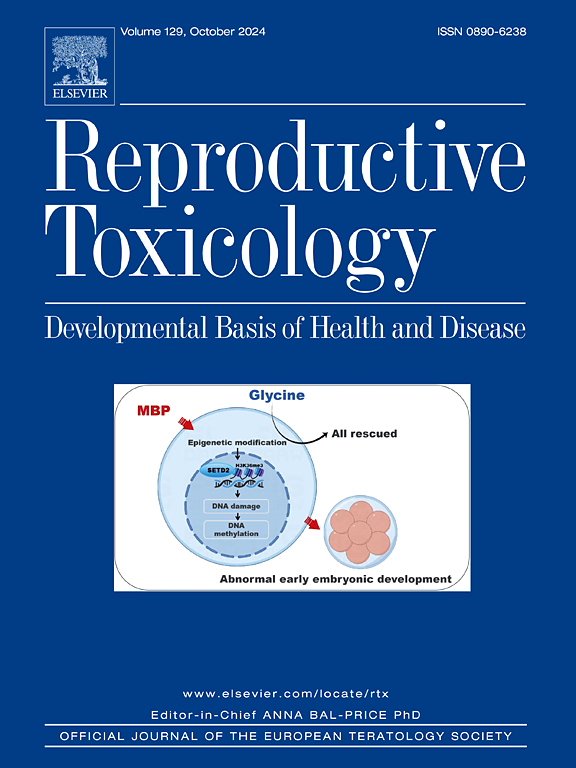长期口服氟西汀导致小鼠雄性生殖功能下降,停药后逐渐恢复。
IF 3.3
4区 医学
Q2 REPRODUCTIVE BIOLOGY
引用次数: 0
摘要
氟西汀是一种广泛使用的选择性血清素再摄取抑制剂(SSRI),对治疗抑郁症等精神疾病非常有效。最近,氟西汀对男性生殖功能的潜在负面影响引起了人们的关注,但长期接触氟西汀造成的睾丸损伤能否在停药后恢复,目前尚不清楚。将雄性C57BL/6小鼠分为对照组(生理盐水)和治疗组(氟西汀,20mg/kg.d),口服4周。这种持续时间和剂量已被证明对小鼠有显著的抗抑郁作用。然后在三个时间点进行生育能力评估和安乐死:停药后立即,停药后4周和停药后8周(n=8)。结果发现,与对照组相比,长期服用氟西汀后,雄性小鼠的交配指数和生育指数明显降低,精子数量和活力下降,精子畸形增加。睾丸组织学显示精管腔内有未成熟的生殖细胞,同时精管上皮厚度、精管直径和Johnsen评分显著降低。增殖标志物Ki67表达降低,凋亡标志物Caspase3表达升高。停药后4周,氟西汀治疗组Ki67和Caspase3水平恢复到对照水平,其他参数部分恢复。8周时,所有测量参数基本归一化,生殖功能明显恢复。这些发现为氟西汀的生殖毒性提供了新的见解,对药物评估中评估其临床安全性至关重要。本文章由计算机程序翻译,如有差异,请以英文原文为准。
Long-term oral fluoxetine leads to reduced male reproductive function in mice and gradual recovery after discontinuation
Fluoxetine, a widely used selective serotonin reuptake inhibitor (SSRI), is highly effective in treating psychiatric disorders such as depression. Recently, its potential negative impact on male reproductive function has recently raised concerns, but it remains unknown whether testicular damage from long-term fluoxetine exposure can recover after stopping the drug. In this study, male C57BL/6 mice were divided into control (saline) and treatment (fluoxetine, 20 mg/kg.d) groups, administered orally for 4 weeks. This duration and dosage have been proven to demonstrate significant antidepressant effects in mice. Fertility assessments and euthanasia was then performed at three time points: immediately after treatment cessation, 4 weeks post-discontinuation, and 8 weeks post-discontinuation (n = 8). Results found that following long-term fluoxetine administration, male mice exhibited significantly reduced mating and fertility indices, decreased sperm count and motility, and increased sperm deformities compared to the control group. Testicular histology showed immature germ cells within the seminiferous tubule lumens, along with significantly reduced seminiferous epithelial thickness, seminiferous tubule diameter, and Johnsen score. Ki67 (proliferation marker) expression decreased, while Caspase3 (apoptosis marker) increased. By 4 weeks post-discontinuation, Ki67 and Caspase3 levels in the fluoxetine-treated group returned to control levels, with partial recovery in other parameters. By 8 weeks, all measured parameters had largely normalized, indicating significant recovery in reproductive function. These findings provided novel insights into fluoxetine's reproductive toxicity and were crucial for assessing its clinical safety in drug evaluations.
求助全文
通过发布文献求助,成功后即可免费获取论文全文。
去求助
来源期刊

Reproductive toxicology
生物-毒理学
CiteScore
6.50
自引率
3.00%
发文量
131
审稿时长
45 days
期刊介绍:
Drawing from a large number of disciplines, Reproductive Toxicology publishes timely, original research on the influence of chemical and physical agents on reproduction. Written by and for obstetricians, pediatricians, embryologists, teratologists, geneticists, toxicologists, andrologists, and others interested in detecting potential reproductive hazards, the journal is a forum for communication among researchers and practitioners. Articles focus on the application of in vitro, animal and clinical research to the practice of clinical medicine.
All aspects of reproduction are within the scope of Reproductive Toxicology, including the formation and maturation of male and female gametes, sexual function, the events surrounding the fusion of gametes and the development of the fertilized ovum, nourishment and transport of the conceptus within the genital tract, implantation, embryogenesis, intrauterine growth, placentation and placental function, parturition, lactation and neonatal survival. Adverse reproductive effects in males will be considered as significant as adverse effects occurring in females. To provide a balanced presentation of approaches, equal emphasis will be given to clinical and animal or in vitro work. Typical end points that will be studied by contributors include infertility, sexual dysfunction, spontaneous abortion, malformations, abnormal histogenesis, stillbirth, intrauterine growth retardation, prematurity, behavioral abnormalities, and perinatal mortality.
 求助内容:
求助内容: 应助结果提醒方式:
应助结果提醒方式:


